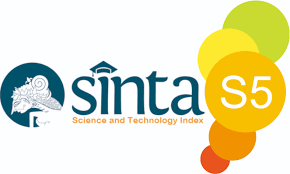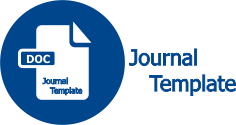Pengembangan Model Prediksi Diabetes Melitus Menggunakan Metode Stochastic Gradient Boosting
Abstract
Keywords
Full Text:
PDFReferences
T. Rawung, J. Posangi, and E. Nangoy, “Efektivitas Penggunaan Empagliflozin terhadap Nilai HbA1c pada Pasien Diabetes Melitus Tipe 2,” Med. Scope J., vol. 5, no. 2, pp. 232–239, 2023, doi: 10.35790/msj.v5i2.45424.
H. Y. Resti and W. H. Cahyati, “Kejadian Diabetes Melitus Pada Usia Produktif Di Puskesmas Kecamatan Pasar Rebo,” Higeia J. Public Heal. Res. Dev., vol. 6, no. 3, pp. 350–361, 2022.
K. W. D. Nugraha, T. Seviana, and F. Sibuea, Profil Kesehatan Indonesia 2022. Jakarta: Kementerian Kesehatan Republik Indonesia Jalan, 2023.
A. Priyanto and E. D. H. Suprayetno, Efektifitas Self Detection For Diabetic (SEDAB) Untuk Deteksi Dini Diabetes Militus. Malang: Media Nusa Creative (MNC Publishing), 2022.
A. Sah, J. Jusmawati, S. Nurhayati, M. Tonggiroh, and S. Bonay, “Sistem Informasi Manajemen Pada Puskesmas Kota Jayapura Berbasis Web,” JTIM J. Teknol. Inf. dan Multimed., vol. 4, no. 3, pp. 212–220, Nov. 2022.
A. Sah, S. Suhardi, and S. Nurhayati, “Geographic Information System of Patient Development in Jayapura Hospital During Pandemic,” J. Teknol. Dan Open Source, vol. 4, no. 2, pp. 149–154, 2021.
R. I. Borman and M. Wati, “Penerapan Data Maining Dalam Klasifikasi Data Anggota Kopdit Sejahtera Bandarlampung Dengan Algoritma Naïve Bayes,” J. Ilm. Fak. Ilmu Komput., vol. 9, no. 1, pp. 25–34, 2020.
R. I. Borman, R. Napianto, N. Nugroho, D. Pasha, Y. Rahmanto, and Y. E. P. Yudoutomo, “Implementation of PCA and KNN Algorithms in the Classification of Indonesian Medicinal Plants,” in International Conference on Computer Science, Information Technology and Electrical Engineering (ICOMITEE), IEEE, 2021, pp. 46–50.
P. N. Sabrina and A. Komarudin, “Prediksi Penyakit Diabetes Dengan Metode K-Nearest Neighbor (KNN) dan Seleksi Fitur Information Gain,” JATI (Jurnal Mhs. Tek. Inform., vol. 8, no. 6, pp. 11320–11326, 2024.
G. A. Putri, A. Trimaysella, and A. Khoiriah, “Penerapan Klasifikasi Data Mining pada Diabetes Menggunakan Metode Naive Bayes,” J. Ilmu Komput. Teknol. Terap., vol. 1, no. 14, pp. 1–9, 2024.
A. W. Mucholladin, F. A. Bachtiar, and M. T. Furqon, “Klasifikasi Penyakit Diabetes menggunakan Metode Support Vector Machine,” J. Pengemb. Teknol. Inf. dan Ilmu Komput., vol. 5, no. 2, pp. 622–633, 2021.
R. Ahsana, R. Rohmat Saedudin, and V. P. Widartha, “Perbandingan Akurasi Algoritma Adaboost dan Algoritma Lightgbm Untuk Klasifikasi Penyakit Diabetes,” e-Proceeding Eng., vol. 8, no. 5, pp. 9738–9748, 2021.
A. F. L. Ptr, M. M. Siregar, and I. Daniel, “Analysis of Gradient Boosting, XGBoost, and CatBoost on Mobile Phone Classification,” J. Comput. Networks, Archit. High Perform. Comput., vol. 6, no. 2, pp. 661–670, 2024.
I. K. Ananda, A. Z. Fanani, D. Setiawan, and D. F. Wicaksono, “Penerapan Random Oversampling dan Algoritma Boosting untuk Memprediksi Kualitas Buah Jeruk,” Edumatic J. Pendidik. Inform., vol. 8, no. 1, pp. 282–289, 2024.
U. Schroeders, C. Schmidt, and T. Gnambs, “Detecting Careless Responding in Survey Data Using Stochastic Gradient Boosting,” Educ. Psychol. Meas., vol. 82, no. 1, pp. 29–56, Apr. 2021, doi: 10.1177/00131644211004708.
A. Subasi, M. F. El-Amin, T. Darwich, and M. Dossary, “Permeability prediction of petroleum reservoirs using stochastic gradient boosting regression,” J. Ambient Intell. Humaniz. Comput., vol. 13, no. 7, pp. 3555–3564, 2022, doi: 10.1007/s12652-020-01986-0.
J. Dasilva, “Diabetes Dataset,” Kaggle. [Online]. Available: https://www.kaggle.com/datasets/johndasilva/diabetes
R. I. Borman, Y. Fernando, and Y. E. P. Yudoutomo, “Identification of Vehicle Types Using Learning Vector Quantization Algorithm with Morphological Features,” J. RESTI (Rekayasa Sist. dan Teknol. Informasi), vol. 5, no. 2, pp. 339–345, 2022.
M. F. El-Amin, “Turbulent Reynolds Stresses Prediction using Stochastic Gradient Boosting Regression,” in 21st Learning and Technology Conference (L&T), 2024, pp. 139–143. doi: 10.1109/LT60077.2024.10468734.
R. Setiawan, A. T. Wibowo, and M. Ridwan, “Pengembangan Sistem Rekomendasi Atlet Esports Berdasarkan Prediksi Elo Rating Menggunakan Model Stochastic Gradient Boosting,” J. Format, vol. 11, no. 2, pp. 145–152, 2022.
M. Kivrak, “Breast Cancer Risk Prediction with Stochastic Gradient Boosting,” Clin. Cancer Investig. J., vol. 11, no. 2, pp. 26–31, 2022, doi: 10.51847/21qrrkLo4Y.
E. E. Başakın, Ö. Ekmekcioğlu, P. C. Stoy, and M. Özger, “Estimation of daily reference evapotranspiration by hybrid singular spectrum analysis-based stochastic gradient boosting,” MethodsX, vol. 10, p. 102163, 2023, doi: https://doi.org/10.1016/j.mex.2023.102163.
N. Hafiizah and R. A. Saputra, “Klasifikasi Kematangan Buah Jeruk Berdasarkan Fitur Warna Menggunakan Metode SVM,” FORMAT J. Ilm. Tek. Inform., vol. 13, no. 1, pp. 55–65, 2024.
R. I. Borman, F. Rossi, Y. Jusman, A. A. A. Rahni, S. D. Putra, and A. Herdiansah, “Identification of Herbal Leaf Types Based on Their Image Using First Order Feature Extraction and Multiclass SVM Algorithm,” in International Conference on Electronic and Electrical Engineering and Intelligent System (ICE3IS), IEEE, 2021, pp. 12–17.
DOI: http://dx.doi.org/10.22441/format.2025.v14.i1.002
Refbacks
- There are currently no refbacks.
Copyright (c) 2025 Format : Jurnal Ilmiah Teknik Informatika

This work is licensed under a Creative Commons Attribution-NonCommercial-NoDerivatives 4.0 International License.
Format : Jurnal Ilmiah Teknik Informatika
Fakultas Ilmu Komputer Universitas Mercu Buana
Jl. Raya Meruya Selatan, Kembangan, Jakarta 11650
Tlp./Fax: +62215840816
http://publikasi.mercubuana.ac.id/index.php/format

|

Ciptaan disebarluaskan di bawah Lisensi Creative Commons Atribusi-NonKomersial 4.0 Internasional.











